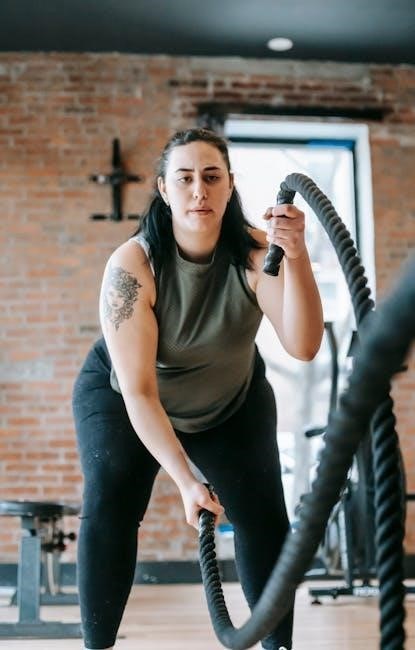Vocal Function Exercises (VFEs) are therapeutic exercises designed to restore and enhance vocal health. Developed by Joseph C. Stemple, VFEs target specific muscles involved in voice production. They are widely used for both rehabilitation and vocal improvement, focusing on strengthening vocal fold function and coordination. These exercises are based on scientific principles and are often recommended for individuals with voice disorders or those seeking to improve their vocal performance. By practicing VFEs, individuals can achieve better vocal clarity, strength, and endurance, making them a valuable tool for singers, speakers, and voice therapy patients alike.
What Are Vocal Function Exercises (VFEs)?
Vocal Function Exercises (VFEs) are a structured set of exercises designed to improve vocal health and function. Developed by Joseph C. Stemple, these exercises target the muscles involved in voice production, focusing on strength, coordination, and endurance. VFEs typically include activities like sustaining vowels, scales, glides, and messa di voce exercises. They are often used in voice therapy to address disorders such as vocal fatigue, breathiness, and poor pitch control. By enhancing vocal fold function and respiratory support, VFEs help individuals achieve clearer, stronger, and more consistent vocal output. These exercises are particularly beneficial for singers, actors, and public speakers seeking to optimize their vocal performance. VFEs are evidence-based and have been widely adopted as a cornerstone of vocal rehabilitation and training programs.


History and Development of VFEs
Vocal Function Exercises (VFEs) were developed in the 1980s by Joseph C. Stemple, a prominent voice therapist and researcher. Stemple designed these exercises to address the need for a systematic approach to vocal rehabilitation and improvement. The exercises were created based on extensive research into vocal anatomy, physiology, and the principles of motor learning. VFEs were initially introduced as a tool for voice therapy, targeting individuals with vocal disorders such as vocal fold dysfunction and chronic hoarseness. Over time, their effectiveness led to their adoption by singers, actors, and public speakers seeking to enhance their vocal performance. The exercises have since become a cornerstone of voice therapy and training programs worldwide, with ongoing research continuing to validate their benefits and refine their application.

Benefits of Vocal Function Exercises
Vocal Function Exercises (VFEs) offer numerous benefits, including improved vocal strength, enhanced clarity, and increased endurance. They also reduce vocal fatigue and promote better breath support for sustained performance.
Improved Vocal Health and Strength
Vocal Function Exercises (VFEs) are specifically designed to enhance vocal health and strength by targeting the muscles involved in voice production. These exercises focus on improving the coordination and power of the vocal folds, which are essential for producing clear and resonant sounds. Regular practice of VFEs can lead to increased vocal endurance, allowing individuals to maintain consistent tone and pitch over extended periods. Additionally, VFEs help in reducing vocal strain and fatigue, making them particularly beneficial for singers, actors, and public speakers who rely heavily on their voice. By strengthening the vocal muscles, these exercises also contribute to better overall vocal hygiene and reduce the risk of voice-related injuries. The structured approach of VFEs ensures gradual and sustainable improvement in vocal health and strength.
Increased Vocal Power and Projection

Vocal Function Exercises (VFEs) are highly effective in enhancing vocal power and projection by improving the efficiency of the vocal mechanism. These exercises focus on strengthening the vocal folds and enhancing breath support, which are critical for producing a strong and resonant voice. By practicing VFEs regularly, individuals can achieve greater vocal intensity and clarity, allowing their voice to carry further and be heard more distinctly. The exercises also work on improving vocal placement and resonance, ensuring that the voice projects evenly across different registers. This makes VFEs particularly beneficial for singers, actors, and public speakers who need to deliver performances with confidence and impact. The structured approach of VFEs helps in developing consistent vocal power, enabling individuals to maintain a strong and commanding voice during extended use.
Reduced Vocal Fatigue
Vocal Function Exercises (VFEs) play a significant role in reducing vocal fatigue by improving the efficiency of the vocal mechanism. These exercises focus on enhancing proper breathing techniques, strengthening the vocal muscles, and promoting optimal vocal fold function. By practicing VFEs, individuals can develop better coordination between their breath support and vocal production, which reduces the strain on the voice during prolonged use. The exercises also help in maintaining consistent vocal quality, even during extended periods of speaking or singing. This makes VFEs particularly beneficial for professionals who rely heavily on their voice, such as teachers, singers, and public speakers. Regular practice of VFEs can lead to less physical effort and discomfort, allowing individuals to use their voice with greater ease and endurance. Over time, this results in reduced vocal fatigue and a more sustainable vocal performance.

How to Perform Vocal Function Exercises
Vocal Function Exercises involve specific techniques to strengthen vocal muscles and improve coordination. They require consistent practice, a stopwatch for timing, and a tracker to monitor progress effectively.

Step-by-Step Guide to VFEs
Prepare Materials: Begin by gathering a stopwatch, a writing implement, and a Vocal Function Tracker to monitor progress. Ensure a quiet environment for focused practice.
Warm-Up: Start with light vocalizations, such as humming or gentle glides, to activate vocal muscles. This step ensures readiness for more intense exercises.
Perform Exercises:
– Exercise 1: Sustain an /s/ sound softly, gradually increasing duration.
– Exercise 2: Produce an /m/ sound with a closed mouth, feeling vibrations in the mask of the face.
– Exercise 3: Transition between high and low pitches using an /o/ or /i/ vowel.
– Exercise 4: Alternate between a soft and loud voice on a sustained vowel.
Track Progress: Record phonation time, pitch accuracy, and comfort levels using the tracker.
Cool-Down: End with gentle humming or soft speaking to relax the vocal system.
Practice Regularly: Aim for 10-15 minutes daily to see consistent improvement.
Remember, consistency and proper technique are key to maximizing the benefits of VFEs. Always consult a professional for personalized guidance.

Tools and Resources for Effective Practice
To effectively practice Vocal Function Exercises (VFEs), several tools and resources are essential. A stopwatch is crucial for measuring phonation time and tracking progress over sessions. Additionally, a writing implement and a Vocal Function Tracker are necessary to record improvements in vocal strength, pitch accuracy, and comfort levels. Audio samples and starting pitches, often provided in VFE guides or PDF resources, help ensure proper technique. Instructional materials, such as detailed step-by-step guides, are invaluable for understanding each exercise’s nuances. Digital apps designed for vocal training can also enhance practice by offering real-time feedback on pitch, volume, and breath control. Access to instructional videos or workshops led by voice professionals can further refine skills. These tools collectively support consistent and effective VFE practice, helping individuals achieve their vocal goals efficiently.
Advanced Techniques and Modifications
Advanced techniques involve customizing Vocal Function Exercises for specific vocal needs and incorporating them into daily practice routines for sustained improvement and enhanced vocal performance.

Customizing VFEs for Specific Vocal Needs
Vocal Function Exercises can be tailored to address individual vocal challenges and goals. For instance, adjustments in pitch, volume, and duration can be made to suit different vocal types. Professionals often modify VFEs to focus on specific areas, such as improving vocal agility or enhancing resonance. Customization ensures that exercises align with the user’s unique needs, whether for rehabilitation or performance enhancement. For example, singers may incorporate dynamics or articulation exercises, while individuals with voice disorders might focus on gentle, controlled phonations. This adaptability makes VFEs versatile and effective for a wide range of vocal objectives. Regular practice and professional guidance are key to maximizing their benefits and achieving optimal vocal health.
Incorporating VFEs into Daily Vocal Practice
Incorporating Vocal Function Exercises into daily practice is essential for maintaining and improving vocal health. Start with short, manageable sessions of 5–10 minutes, gradually increasing as comfort and strength improve. Begin with simple exercises like lip trills or tongue trills to engage the vocal muscles gently. Use tools like a stopwatch or mobile app to track progress, such as phonation time or pitch accuracy. For singers and speakers, integrate VFEs into warm-up routines to enhance performance and reduce fatigue. Consistency is key; even brief daily practice can lead to noticeable improvement over time. Over weeks, adapt exercises to address specific needs, ensuring they remain challenging yet achievable. This structured approach fosters long-term vocal development and sustainability.



